Day 1 found me working my way south and east from San Antonio towards Corpus Christi. Just north of there is the Aransas National Wildlife Refuge, my first birding destination. Despite only spending four hours at the refuge, I was still able to identify 53 different species, eleven of which I had never seen before, my lifers for the day. The term "lifer" or "life-species" is usually used to describe birds never before seen by you, and which now can be added to your "life list". My life list documents the date and location of the first time I ever saw a particular species.
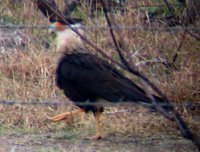
Here are two of my eleven lifers from Day 1 (yesterday). On the left is a Crested Caracara, a vulturey raptor that I've wanted to see for a long time. Too bad it turned out a bit fuzzy. This is undoubtedly one of the most "bad-ass" birds I've ever seen. This one was hanging out on the side of the road sharing a dead opossum with another caracara. They look like they should be hanging out in the Serengeti rather than Texas.
 This is a Golden-fronted Woodpecker, one of two new woodpeckers species I saw during my birding trip.
This is a Golden-fronted Woodpecker, one of two new woodpeckers species I saw during my birding trip.Below are a bunch of Black-bellied Whistling Ducks, another species I've been wanting to see for a while. Their bills were a crazy neon orange color that could be seen distinctly from a hundred yards away.

Here are the rest of my lifers for day one: Neotropic Cormorant, Harris Hawk, American Avocet, White-winged Dove, Ladder-backed Woodpecker, Couch's Kingbird, Eastern Meadowlark, and the incredibly endangered Whooping Crane. The Whoopers were my main reason for visiting Aransas. I only saw three of them, and they were pretty far off in the distance, but seeing them is something I have wanted to do since I first learned what it meant when a species is "endangered." Yesterday was a good day.
When I woke up this morning I was determined to one-up my experience from yesterday. Things got off to a good start right off the bat as I spotted a flock of Green Parakeets flying over Brownsville. This is the only town in the U.S. where you stand a chance of seeing these birds. I didn't get much of a look at them. I probably could have scouted around a bit more to see them better, but considering that it was 37 degrees and windy I figured it would be better to get into the forest of Sabal Palm Grove Sanctuary as early as possible. On a side note, it was colder where I was this morning, only 100 feet from Mexico at the southernmost tipe of Texas, than it was in Seward. Go figure. When I arrived at the bird sanctuary I was greeted immediately by a flock of the most striking birds I have ever seen. Green Jays are a mexican species that have only recently begun to move into the Rio Grande Valley of south Texas. This is one of the more reliable places to see them.
When I arrived at the bird sanctuary I was greeted immediately by a flock of the most striking birds I have ever seen. Green Jays are a mexican species that have only recently begun to move into the Rio Grande Valley of south Texas. This is one of the more reliable places to see them. These birds thought it would be funny to follow me along the trail, scolding me the entire way in an attempt to scare away all the other birds. It probably would have worked if they hadn't gotten distracted by a big bobcat that paused to check me out for a few minutes. I guess they thought following the bobcat would be more funner.
These birds thought it would be funny to follow me along the trail, scolding me the entire way in an attempt to scare away all the other birds. It probably would have worked if they hadn't gotten distracted by a big bobcat that paused to check me out for a few minutes. I guess they thought following the bobcat would be more funner.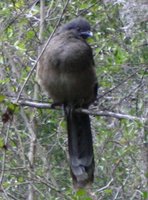 The Plain Chachalaca quickly became one of my favorite lifers of this trip. They were awesome. And they had some really great skills. Seriously, they did! Later this morning when I got back to the trailhead I saw a flock of about eight of these chicken-sized birds hanging out beneath the bird feeder the Green Jay is hanging off of in the picture above. When the jays would leave for a few minutes, the chachalacas would get impatient for more food, so they'd send one of them up a nearby branch where he would launch himself at the feeder, kicking it hard enough to knock a handful of birdseed out of it as he flopped to the ground. I sat there for over a half hour watching this. It was flippin' sweet!
The Plain Chachalaca quickly became one of my favorite lifers of this trip. They were awesome. And they had some really great skills. Seriously, they did! Later this morning when I got back to the trailhead I saw a flock of about eight of these chicken-sized birds hanging out beneath the bird feeder the Green Jay is hanging off of in the picture above. When the jays would leave for a few minutes, the chachalacas would get impatient for more food, so they'd send one of them up a nearby branch where he would launch himself at the feeder, kicking it hard enough to knock a handful of birdseed out of it as he flopped to the ground. I sat there for over a half hour watching this. It was flippin' sweet!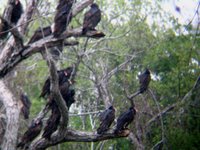 Then there were the Turkey Vultures. These weren't lifers for me, but there had to be thousands of the stupid birds in the refuge. And every single time i would round a corner fifty or sixty of them would launch into the air from their perches, scaring the crap out of me and silencing any other birds within earshot. It did make for a cool spectacle, though, watching several thousand big vultures swarming all around like flies.
Then there were the Turkey Vultures. These weren't lifers for me, but there had to be thousands of the stupid birds in the refuge. And every single time i would round a corner fifty or sixty of them would launch into the air from their perches, scaring the crap out of me and silencing any other birds within earshot. It did make for a cool spectacle, though, watching several thousand big vultures swarming all around like flies.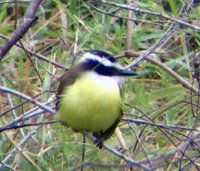 Next we've got the Great Kiskadee, a type of tropical kingbird, on the left. On the right is a picture of a Gadwall (not a lifer for me) next to a much smaller Least Grebe, another south Texas specialty. The grebe was hanging out below a blind set up along the trail, so I got to watch it swim around for quite a while.
Next we've got the Great Kiskadee, a type of tropical kingbird, on the left. On the right is a picture of a Gadwall (not a lifer for me) next to a much smaller Least Grebe, another south Texas specialty. The grebe was hanging out below a blind set up along the trail, so I got to watch it swim around for quite a while.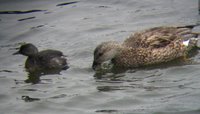
The kiskadee was really neat, too. I'm bummed that this picture is a bit fuzzy. I tried taking another one when it perched on the railing of the boardwalk about ten feet way, but the moment I moved it flew off and I didn't see it again.
Finally, we've got the Altamira Oriole. I'm really proud of this photo. It took a while (and a lot of fiddling around with the camera controls) to finally score this one. I might try to print out a copy and get it framed. The sanctuary staff had nailed up a bunch of grapefruit halves to the trees in order to attract the orioles. I remember doing something similar as a kid in Minnesota...with mixed results. Well, it worked this time. The oriole kept coming back to snack on the fruit. I even saw him try out the feeder when the jays weren't around.
Total species for day 2: 41 (13 of those were lifers). I think the novelty of seeing so many mexican birds in such a short amount of time made today a more rewarding experience for me. The rest of my lifers for today included: Olive Sparrow, Inca Dove, White-tipped Dove, Ringed Kingfisher, Tamaulipas Crow, Black-crested Titmouse, and a Long-billed Thrasher.



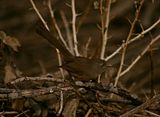











2 comments:
Beautiful photos, and congrats on the oriole photo through the binoculars. I too am learning to digiscope and I just built my own spotting scope. Please see my "beginning to bird" blog. (Sorry I don't know how to do an embedded link!)
nice! My camera lens won't fit into my Swarovski's eyepiece or I'd try the digibinning thing!
Post a Comment